Abstract
An efficient way to access highly functionalized proline derivatives was developed based on a Cu(I)-catalyzed reaction between CF3-substituted allenynes and tosylazide, which involved a cascade of [3 + 2]-cycloaddition/ketenimine and a rearrangement/Alder-ene cyclization to afford the new proline framework with a high diastereoselectivity.
1. Introduction
Proline and its functionalized derivatives are constituents of numerous natural products [1,2,3] and are widely used as pharmaceuticals, in biomedical research and as templates in structure–function relationship studies directed toward the elucidation of biologically active conformations [4,5]. In this context, ring-substituted and quaternary proline analogues are of particular interest [6,7,8,9,10,11,12,13]. Some representative examples of bioactive prolines are depicted in Figure 1. Because of the unique properties of fluorine-containing compounds [14,15,16,17,18], fluorinated α-amino acids, especially their α-fluoromethyl substituted counterparts [19,20,21,22,23], which can function as selective enzyme inhibitors [24,25], are very attractive target molecules for the design of biologically active compounds.

Figure 1.
Selected examples of bioactive functionalized prolines.
Recently, we elaborated on a straightforward way to access functionalized allenynes 2 based on the [2,3]-sigmatropic rearrangement of propargyl-containing nitrogen ylides generated in situ from α-CF3-diazo Compounds 1 and N,N-bis(propargyl)methylamine (Scheme 1A) [26]. Allenynes 2 have proved to be unique doubly unsaturated synthons that can afford a variety of the corresponding α-amino acid derivatives. Thus, the potential of 2 has been clearly revealed in their synthetic transformation under transition metal catalysis, e.g., during Pd-catalyzed Sonogashira coupling followed by intramolecular [2 + 2] cycloaddition [27] and a co-mediated Pauson–Khand reaction [26], Cu-catalyzed tandem amination/cyclization [28] and in intermolecular Ru-catalyzed dimerization [29] (Scheme 1B). Now we wish to disclose a highly diastereoselective pathway to new densely functionalized proline derivatives via a cascade reaction between allenynes 2 and tosylazide, which is involved in Cu(I)-catalyzed alkyne-azide [3 + 2]-cycloaddition, ketenimine rearrangement and Alder-ene cyclization (Scheme 1C). To the best of our knowledge, this type of 1,6-allenyne transformation under metal catalysis to access proline derivatives has been not reported before.
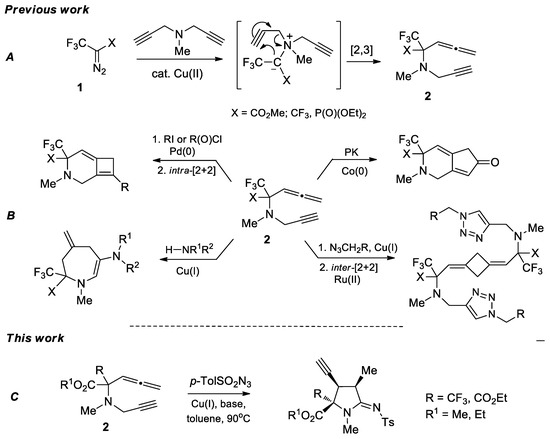
Scheme 1.
Previous (A,B) and present (C) work.
2. Results and Discussion
In continuation of our long-term program on the synthesis of new fluorinated amino acids using the transition-metal catalyzed transformation of the unsaturated precursors [30,31,32,33,34], we tested the Cu(I)-catalyzed [3 + 2] cycloaddition reaction of allenyne 2a with tosylazide, and we initially planned to obtain the corresponding allene-containing 1,2,3-triazole for the investigation of its further chemical behavior, keeping in mind that 1,2,3-triazoles with an electron-withdrawing aryl sulfonyl group on nitrogen are able to form extremely reactive carbenoid species under metal catalysis [35,36,37,38,39]. However, during the course of screening the optimal conditions and catalytic systems, the formation of CF3-substituted proline derivative 4a was unexpectedly revealed in a good yield and had an excellent diastereoselectivity (Scheme 2). The only diastereomer 4a was easily isolated in its pure form via column chromatography on silica gel; its structure was unambiguously confirmed by NMR-spectroscopy (1H, 13C and 19F) and X-ray analysis (Figure 2). The best yield of proline 4a (62%) can be achieved by heating equimolar amounts of reagents in toluene at 90 °C in the presence of CuI (10 mol%) and 2,6-dimethylpyridine (1.5 equiv.) as a base for 8 h. The usage of other copper catalysts (CuBr, CuTC, cationic complex Cu(MeCN)4PF6), organic bases (Et3N, DIPEA and pyridines) and solvents (DCE, chloroform and dioxane)) leads to a significant decrease in the product yield.

Scheme 2.
Synthesis of 3-ethynyl-pyrrolidine-2-carboxylate 4a.
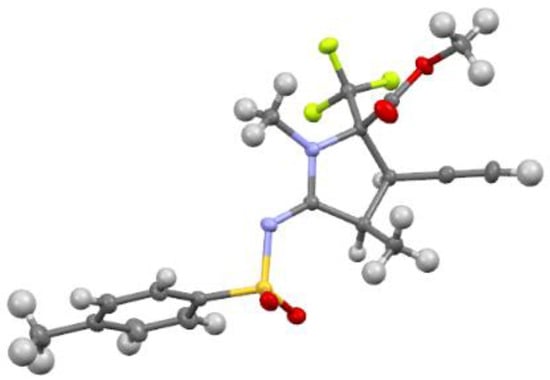
Figure 2.
Structure of proline 4a (CCDC 2208592).
Then, we discovered that if the reaction is carried out at room temperature, another product, acrylamidine 3a, is formed. The latter compound was isolated in a 60% yield and was fully characterized using standard physico-chemical methods. It was also found that allene-containing acrylamidine 3a is able to undergo intramolecular cyclization under heating in toluene at 90 °C in the absence of any catalysts yielding proline 4a almost quantitatively (Scheme 2).
A feasible reaction pathway (Scheme 3) may include the initial formation of copper triazolide A, which can be further transformed into the corresponding ketenimine B via the release of nitrogen gas [40,41,42,43]. The latter undergoes a skeleton rearrangement via the formation of a relatively unstable four-membered ring intermediate C, leading to acrylamidine 3a. A similar rearrangement has been previously described for the intramolecular annulation of N-tethered N-sulfonyl-1,2,3-triazoles [44]. Finally, the intramolecular Alder-ene cycloisomerization of allene-containing acrylamidine 3a (1,6-allenene) occurs with the participation of an allene hydrogen through the concerted six-center transition state D to give the product 4a with a high degree of diastereoselectivity. Such a thermal ene-type reaction, in which the terminal allene acts as the ene-component and the alkene as the enophile, has not been previously described. The closest literature analogy includes the Alder-ene cycloisomerization of 1,6-allenynes, namely α-allenyl propiolamides [45].
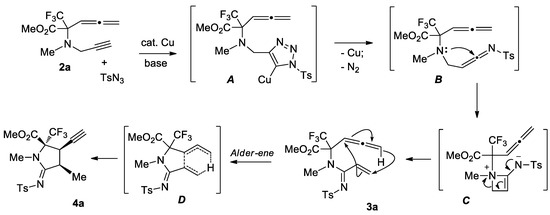
Scheme 3.
Plausible reaction pathways.
It turns out that the analogous cascade process also takes place in the case of readily available allenyne 1b [29] to afford the corresponding proline 4b as a single diastereomer in an acceptable isolated yield under the same catalytic conditions (Scheme 4).

Scheme 4.
Synthesis of 3-ethynyl-pyrrolidine-2,2-dicarboxylate 4b.
The presence of an ethynyl group in the structure of prolines 4a,b makes them unique synthons for further useful transformations. For instance, 3-ethynyl substituted prolines and their triazole-containing derivatives have been recently applied as universal building blocks for the development of new ligands for the activation of ionotropic glutamate receptors, which are important excitatory neurotransmitters in the central nervous system [13,46]. Therefore, in order to demonstrate one of the possible synthetic utilizations of the new compounds 4a,b, we investigated their Cu(I)-catalyzed alkyne-azide coupling, i.e., the so-called “click” reaction, with alkyl and aryl azides. For these purposes, a series of copper (I)/organic base systems were tested to activate the reaction. As a result, it was revealed that the optimum condition providing the best yields of the target triazoloprolines 5 and 6 was the usage of copper thiophene-2-carboxylate (CuTC) in amounts of 5 mol.% in the absence of any base. The reaction went to completion at room temperature in toluene for 4 h (Scheme 5).
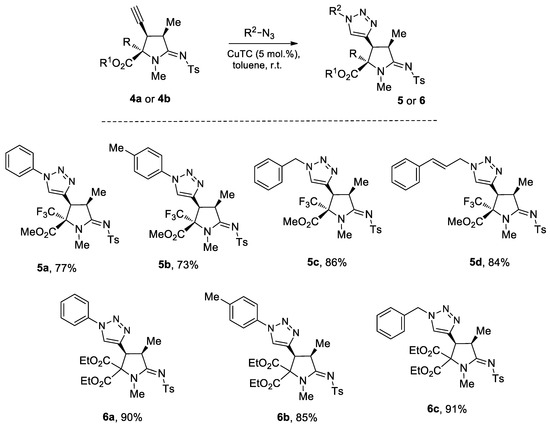
Scheme 5.
Synthesis of triazoloprolines 5 and 6.
3. Materials and Methods
3.1. General Information
All the solvents used in the reactions were freshly distilled from appropriate drying agents before use. All the reagents were used as purchased from Sigma-Aldrich (Munich, Germany). An analytical TLC was performed with Merck silica gel 60 F254 plates (Darmstadt, Germany), and visualization was accomplished with UV light, iodine vapors or by spraying with Ce(SO4)2 solution in 5% H2SO4. Chromatography was carried out using Merck silica gel (Kieselgel 60, 0.063–0.200 mm, Darmstadt, Germany) and petroleum ether/ethyl acetate as an eluent. NMR spectra were obtained with Bruker AV-300 (1H, 19F) and AV-400 (1H, 13C, 19F) spectrometers (Karlsruhe, Germany), operating at 400 MHz for 1H (TMS reference), at 101 MHz for 13C, 282 and at 376 MHz for 19F (CCl3F reference). High-Resolution Mass Spectrometry spectra were carried out using AB Sciex Triple TOF 5600+ (Framingham, MA, USA), which supported different ionization sources. The starting allenynes were synthesized via the previously described protocol. The melting points were determined on a Melting Point Apparatus Stuart SMP 10 (Wertheim, Germany) and are uncorrected.
3.2. General Procedure for Preparation of 4a and 4b
An oven-dried 10 mL Schlenk tube equipped with a magnetic stirrer was under vacuum and then back-filled with argon. Under a stream of argon, the allenyne (100 mg, 0.404 mmol) in anhydrous toluene (2 mL) was added, followed by the tosyl azide (84 mg, 0.424 mmol, 1.05 equiv.), CuI (7.7 mg, 10 mol.%) and 2,6-luthidine (65 mg, 0.606 mmol, 1.5 equiv.) sequentially. After the reaction mixture was stirred at RT for 4 h and 90 °C overnight, it was cooled to room temperature and concentrated under reduced pressure. The residue was purified by column chromatography on silica gel (petroleum ether/ethyl acetate) to obtain the desired product 4a and 4b. This procedure worked perfectly on a 0.5 g scale without decreasing the product yield.
3.3. General Procedure for Preparation of 5a–5d and 6a–6c
To a solution of 4a or 4b (0.24 mmol) in anhydrous toluene (2 mL), the corresponding amount of azide (0.48 mmol, 2 equiv.) and CuTC (copper (I) thiophene-2-carboxylate) (2.3 mg, 5 mol.%) was added. The reaction mixture was stirred at room temperature for 4 h. Upon the completion of the reaction (monitored) by TLC, the mixed solvent was removed under reduced pressure and the residue was purified by column chromatography on silica gel (petroleum ether/ethyl acetate, ethyl acetate) to obtain the corresponding triazole.
Methyl 2-(N-methyl-N′-tosylacrylimidamido)-2-(trifluoromethyl)penta-3,4-dienoate (3a)
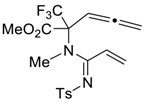
An oven-dried 10 mL Schlenk tube equipped with a magnetic stirrer was under vacuum and then back-filled with argon. Under a stream of argon, the allenyne (100 mg, 0.404 mmol) was added, followed by the tosyl azide (84 mg, 0.424 mmol), CuI (7.7 mg, 10 mol.%) and 2,6-luthidine (65 mg, 0.606 mmol, 1.5 equiv.) in anhydrous toluene (2 mL). After the reaction mixture was stirred at RT for 4h, it was concentrated under reduced pressure. The residue was purified via column chromatography on silica gel (petroleum ether/ethyl acetate) to obtain the desired product 3a.
Yield: 60% (101 mg) as a light-yellow oil. 1H NMR (400 MHz, CDCl3) δ 7.72 (d, J = 8.2 Hz, 2H), 7.27 (d, J = 8.1 Hz, 2H), 6.64 (dd, J = 18.0, 12.0 Hz, 1H), 5.83 (d, J = 12.0 Hz, 1H), 5.72 (d, J = 18.0 Hz, 1H), 5.58 (t, J = 6.7 Hz, 1H), 5.05–4.96 (m, 2H), 3.56 (s, 3H), 3.20 (s, 3H), 2.41 (s, 3H). 19F NMR (376 MHz, CDCl3) δ-67.69. 13C NMR (101 MHz, CDCl3) δ 208.5, 164.7, 164.1, 142.7, 139.5, 129.1, 128.6, 126.8, 126.2, 123.2 (q, J = 288.3 Hz), 85.6, 80.5, 70.5 (q, J = 26.8 Hz), 53.3, 36.6, 21.6. HRMS (ESI): calcd. for C18H20F3N2O4S [M + H]+: 417.1090; found: 417.1096.
(2R*,3R*,4R*,Z)-Methyl 3-ethynyl-1,4-dimethyl-5-(tosylimino)-2-(trifluoromethyl)pyrrolidine-2-carboxylate (4a)
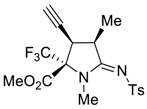
Yield: 62% (104 mg) as a white solid. 1H NMR (400 MHz, CDCl3) δ 7.81 (d, J = 8.2 Hz, 2H), 7.25 (d, J = 8.0 Hz, 2H), 3.99 (p, J = 7.5 Hz, 1H), 3.87 (s, 3H), 3.64 (dd, J = 8.9, 2.5 Hz, 1H), 2.90 (s, 3H), 2.44 (d, J = 2.5 Hz, 1H), 2.38 (s, 3H), 1.54 (d, J = 7.3 Hz, 1H). 19F NMR (376 MHz, CDCl3) δ-71.12. 13C NMR (101 MHz, CDCl3) δ 171.9, 164.8, 142.8, 140.0, 129.4, 126.5, 123.2 (q, J = 286.2 Hz), 75.6 (q, J = 28.6 Hz), 75.3, 53.8, 38.2, 36.4, 30.9, 21.6, 15.6. HRMS (ESI): calcd. for C18H20F3N2O4S [M + H]+: 417.1090; found: 417.1095.
(3R*,4R*,Z)-Diethyl 3-ethynyl-1,4-dimethyl-5-(tosylimino)pyrrolidine-2,2-dicarboxylate (4b)
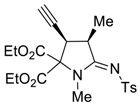
Yield: 45% (79 mg) as a light-yellow oil. 1H NMR (400 MHz, CDCl3) δ 7.83 (d, J = 8.1 Hz, 2H), 7.27 (d, J = 7.8 Hz, 2H), 4.37 – 4.28 (m, 4H), 4.09 (dd, J = 8.5, 2.3 Hz, 1H), 3.97–3.89 (m, 1H), 3.00 (s, 3H), 2.40 (s, 3H), 2.37 (d, J = 2.3 Hz, 1H), 1.52 (d, J = 7.4 Hz, 3H), 1.32 (td, J = 7.1, 3.9 Hz, 6H). 13C NMR (101 MHz, CDCl3) δ 172.0, 166.6, 166.0, 142.5, 140.5, 129.3, 126.5, 76.7, 76.2, 76.0, 63.5, 63.0, 38.7, 38.1, 31.9, 21.6, 15.4, 14.2, 14.1. EA calcd. for C21H26N2O6S (%): C, 58.05; H, 6.03; N, 6.45. Found: C, 57.93; H, 5.99; N, 6.40.
(2R*,3S*,4R*,Z)-Methyl 1,4-dimethyl-3-(1-phenyl-1H-1,2,3-triazol-4-yl)-5-(tosylimino)-2-(trifluoromethyl)pyrrolidine-2-carboxylate (5a)
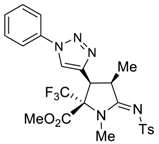
Yield: 77% (99 mg) as a white solid. M.p. 147–149 °C. 1H NMR (400 MHz, CDCl3) δ 7.90 (s, 1H), 7.87 (d, J = 8.0 Hz, 2H), 7.73 (d, J = 7.1 Hz, 2H), 7.55 (t, J = 7.7 Hz, 2H), 7.47 (t, J = 7.8 Hz, 1H), 7.30 (d, J = 8.0 Hz, 2H), 4.26 (d, J = 8.8 Hz, 1H), 4.20–4.13 (m, 1H), 3.86 (s, 3H), 3.02 (s, 3H), 2.43 (s, 3H), 1.49 (d, J = 7.4 Hz, 3H). 13C NMR (101 MHz, CDCl3) δ 173.0, 165.3, 142.7, 140.4, 140.3, 136.7, 129.9, 129.4, 129.1, 126.5, 123.8 (q, J = 286.6 Hz), 122.3, 120.4, 75.6 (q, J = 28.3 Hz), 54.0, 40.6, 40.2, 30.8, 21.6, 16.1. 19F NMR (376 MHz, CDCl3) δ-70.51. EA calcd. for C24H24F3N5O4S (%): C, 53.83; H, 4.52; N, 13.08. Found: C, 54.08; H, 4.55; N. 13.17.
(2R*,3S*,4R*,Z)-Methyl 1,4-dimethyl-3-(1-p-tolyl-1H-1,2,3-triazol-4-yl)-5-(tosylimino)-2-(trifluoromethyl)pyrrolidine-2-carboxylate (5b)
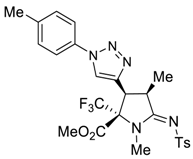
Yield: 73% (96 mg) as a white solid. M.p. 162–164 °C. 1H NMR (300 MHz, CDCl3) δ 7.91–7.83 (m, 3H), 7.59 (d, J = 8.3 Hz, 2H), 7.36–7.27 (m, 4H), 4.26 (d, J = 8.9 Hz, 1H), 4.20–4.11 (m, 1H), 3.86 (s, 3H), 3.02 (s, 3H), 2.43 (s, 6H), 1.48 (d, J = 7.3 Hz, 3H). 19F NMR (376 MHz, CDCl3) δ-70.53. 13C NMR (101 MHz, CDCl3) δ 173.0, 165.3, 142.7, 140.3, 140.2, 139.3, 134.4, 130.4, 129.4, 126.5, 123.8 (q, J = 286.8 Hz), 122.2, 120.4, 75.6 (q, J = 28.0 Hz), 54.0, 40.6, 40.2, 30.9, 21.6, 21.2, 16.1. EA calcd. for C25H26F3N5O4S (%): C, 54.64; H, 4.77; N, 12.74. Found: C, 54.62; H, 4.82; N, 12.75.
(2R*,3S*,4R*,Z)-methyl 3-(1-benzyl-1H-1,2,3-triazol-4-yl)-1,4-dimethyl-5-(tosylimino)-2-(trifluoromethyl)pyrrolidine-2-carboxylate (5c)
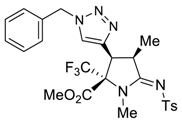
Yield: 86% (113 mg) as a white solid. M.p. 158–160 °C. 1H NMR (400 MHz, CDCl3) δ 7.85 (d, J = 8.2 Hz, 2H), 7.43–7.35 (m, 3H), 7.33 (s, 1H), 7.28 (d, J = 8.2 Hz, 2H), 7.22 (d, J = 5.3 Hz, 2H), 5.60 (d, J = 14.9 Hz, 1H), 5.46 (d, J = 14.9 Hz, 1H), 4.17 (d, J = 8.9 Hz, 1H), 4.05 (p, J = 7.7 Hz, 1H), 3.69 (s, 3H), 2.97 (s, 3H), 2.41 (s, 3H), 1.40 (d, J = 7.4 Hz, 3H). 13C NMR (101 MHz, CDCl3) δ 173.0, 165.4, 142.7, 140.3, 140.1, 134.5, 129.4, 129.1, 128.0, 126.5, 123.8 (q, J = 287.0 Hz), 123.8, 75.7 (q, J = 28.8 Hz), 54.3, 53.8, 40.8, 40.0, 30.9, 21.7, 16.2. 19F NMR (282 MHz, CDCl3) δ-70.50. EA calcd. for C25H26F3N5O4S (%): C, 54.64; H, 4.77; N, 12.74. Found: C, 54.47; H, 4.86; N, 12.73.
(2R*,3S*,4R*,Z)-methyl 3-(1-cinnamyl-1H-1,2,3-triazol-4-yl)-1,4-dimethyl-5-(tosylimino)-2-(trifluoromethyl)pyrrolidine-2-carboxylate (5d)
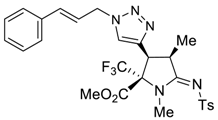
Yield: 84% (116 mg) as a white solid. M.p. 136–138 °C. 1H NMR (400 MHz, Chloroform-d) δ 7.83 (d, J = 8.1 Hz, 2H), 7.51 (s, 1H), 7.37–7.30 (m, 4H), 7.29 (d, J = 5.1 Hz, 1H), 7.24 (s, 2H), 6.58 (d, J = 15.8 Hz, 1H), 6.36–6.26 (m, 1H), 5.10 (t, J = 6.8 Hz, 2H), 4.18 (d, J = 8.9 Hz, 1H), 4.09–4.04 (m, 1H), 3.77 (s, 3H), 2.97 (s, 3H), 2.38 (s, 3H), 1.40 (d, J = 7.4 Hz, 3H). 13C NMR (101 MHz, CDCl3) δ 173.0, 165.3, 142.6, 140.3, 139.8, 135.6, 135.4, 129.3, 128.9, 128.7, 126.8, 126.4, 123.9, 123.8 (q, J = 286.2 Hz), 121.6, 75.7 (q, J = 27.8 Hz), 53.9, 52.4, 40.7, 40.1, 30.8, 21.6, 16.1. 19F NMR (376 MHz, CDCl3) δ -70.5. EA calcd. for C27H28F3N5O4S (%): C, 56.34; H, 4.90; N, 12.17. Found: C, 56.21; H, 4.97; N, 12.29.
(3S*,4R*,Z)-diethyl 1,4-dimethyl-3-(1-phenyl-1H-1,2,3-triazol-4-yl)-5-(tosylimino) pyrrolidine-2,2-dicarboxylate (6a)
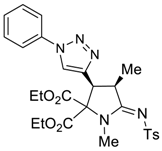
Yield: 90% (120 mg) as a white solid. M.p. 137–139 °C. 1H NMR (400 MHz, CDCl3) δ 7.95 (s, 1H), 7.84 (d, J = 7.9 Hz, 2H), 7.70 (d, J = 7.8 Hz, 2H), 7.50 (t, J = 7.7 Hz, 2H), 7.41 (t, J = 7.4 Hz, 1H), 7.25 (d, J = 8.2 Hz, 2H), 4.64 (d, J = 8.5 Hz, 1H), 4.25 (q, J = 7.1 Hz, 2H), 4.22–4.15 (m, 1H), 4.12–4.04 (m, 2H), 3.09 (s, 3H), 2.38 (s, 3H), 1.50 (d, J = 7.3 Hz, 3H), 1.24 (t, J = 7.3 Hz, 3H), 1.08 (t, J = 7.1 Hz, 3H). 13C NMR (101 MHz, CDCl3) δ 173.0, 166.8, 166.5, 142.4, 141.5, 140.7, 136.9, 129.9, 129.3, 128.9, 126.4, 122.3, 120.4, 63.2, 62.9, 42.9, 40.1, 32.1, 21.6, 15.9, 14.0, 13.8. EA calcd. for C27H31N5O6S (%): C, 58.58; H, 5.64; N, 12.65. Found: C, 58.66; N, 5.67; H, 12.68.
(3S*,4R*,Z)-diethyl 1,4-dimethyl-3-(1-p-tolyl-1H-1,2,3-triazol-4-yl)-5-(tosylimino) pyrrolidine-2,2-dicarboxylate (6b)
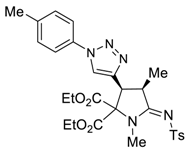
Yield: 85% (116 mg) as a white solid. M.p. 157–158 °C. 1H NMR (400 MHz, CDCl3) δ 7.92 (s, 1H), 7.86 (d, J = 8.0 Hz, 2H), 7.59 (d, J = 8.3 Hz, 2H), 7.31 (d, J = 8.1 Hz, 2H), 7.29–7.26 (d, J = 7.1 Hz, 2H), 4.66 (d, J = 8.4 Hz, 1H), 4.27 (q, J = 6.9 Hz, 2H), 4.23–4.16 (m, 1H), 4.14–4.04 (m, 2H), 3.10 (s, 3H), 2.41 (s, 3H), 2.40 (s, 3H), 1.52 (d, J = 7.4 Hz, 3H), 1.26 (t, J = 7.3 Hz, 3H), 1.09 (t, J = 7.2 Hz, 3H). 13C NMR (101 MHz, CDCl3) δ 173.0, 166.8, 166.6, 142.4, 141.4, 140.7, 139.1, 134.6, 130.4, 129.3, 126.4, 122.2, 120.4, 63.2, 62.9, 43.0, 40.2, 32.1, 21.6, 21.2, 15.9, 14.0, 13.8. EA calcd. for C28H33N5O6S (%): C, 59.24; H, 5.86; N, 12.34. Found: C, 58.99; H, 5.89; N, 12.38.
(3S*,4R*,Z)-diethyl 3-(1-benzyl-1H-1,2,3-triazol-4-yl)-1,4-dimethyl-5-(tosylimino) pyrrolidine-2,2-dicarboxylate (6c)
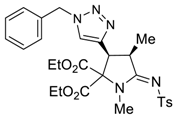
Yield: 91% (124 mg) as a colorless oil. 1H NMR (400 MHz, CDCl3) δ 7.83 (d, J = 8.0 Hz, 2H), 7.39 (s, 1H), 7.37–7.32 (m, 3H), 7.26–7.24 (m, 2H), 7.23–7.19 (m, 2H), 5.54 (d, J = 14.9 Hz, 1H), 5.45 (d, J = 14.9 Hz, 1H), 4.54 (d, J = 8.5 Hz, 1H), 4.21 (q, J = 7.1 Hz, 2H), 4.14–4.06 (m, 1H), 4.01–3.87 (m, 2H), 3.05 (s, 3H), 2.39 (s, 3H), 1.41 (d, J = 7.4 Hz, 3H), 1.19 (t, J = 7.1 Hz, 3H), 1.00 (t, J = 7.2 Hz, 3H). 13C NMR (101 MHz, CDCl3) δ 173.0, 166.8, 166.6, 142.4, 141.3, 140.8, 134.8, 129.3, 129.3, 128.9, 128.0, 126.4, 123.9, 63.1, 62.8, 54.2, 43.1, 40.1, 32.1, 21.6, 15.8, 14.0, 13.7. EA calcd. for C28H33N5O6S (%): C, 59.24; H, 5.86; N, 12.34. Found: C, 59.03; H, 5.85; N, 12.13.
3.4. X-ray Structure Determination of 4a
Crystals (C18H19F3N2O4S, M = 416.41) were monoclinic and had a space group P21/c, at 120K a = 9.7168(13), b = 16.001(2), c = 12.2398(17) Å, β = 99.355(3)°, V = 1877.7(4) Å3, Z = 4, dcalc. = 1.473 g/cm3, μ = 2.29 cm−1. Data collection was carried out with a Bruker SMART APEX II diffractometer, λ(MoKα) = 0.71073 Å, ω-scan technique, T = 120(2) K, 3670 independent reflections (Rint = 0.0674) with 2θmax = 52.0° were collected and used in refinement. The structure was solved with direct methods and were refined using the full matrix least-squares technique against F2 with the anisotropic thermal parameters for all non-hydrogen atoms. At the final stage, the structure was refined as a 2-component twin (the BASF was 0.291(2)). The hydrogen atoms were placed geometrically and were included in the structure factors calculations in the riding motion approximation. The refinement converged to wR2 = 0.1177 and GOF = 1.027 for all the independent reflections (R1 = 0.0492 was calculated against F for 2834 observed reflections with I > 2σ(I)). All the calculations were performed using the SHELXL program package [47]. CCDC deposition number 2208592 contains the supplementary crystallographic data for this paper. These data can be obtained free of charge from The Cambridge Crystallographic Data Centre.
4. Conclusions
In conclusion, we elaborated on an efficient pathway for densely functionalized proline derivatives. The method is based on a Cu(I)-catalyzed reaction between CF3-substituted allenynes and tosylazide, which involves the cascade of [3 + 2]-cycloaddition/ketenimine and a rearrangement/Alder-ene cyclization to afford the new 3-ethynyl proline derivatives in moderate-to-good yields and with a high diastereoselectivity. The synthetic potential of the latter compounds was demonstrated in a Cu(I)-catalyzed “click” reaction with alkyl and aryl azides, which provided access to the corresponding triazole-containing prolines as single diastereomers in high yields.
Supplementary Materials
The following supporting information can be downloaded at: https://www.mdpi.com/article/10.3390/molecules27206898/s1. The following are available online: copies of the 1H, 19F and 13C NMR spectra for all novel compounds (Figures S1–S26).
Author Contributions
Conceptualization, S.N.O.; methodology, S.N.O.; investigation, A.N.P., D.V.V., P.S.G. (synthesis, NMR studies and spectral characterization) and F.M.D. (X-ray investigation); writing–original draft preparation, S.N.O. and A.N.P.; writing–review and editing, P.S.G. and S.N.O.; supervision, S.N.O.; project administration, S.N.O.; funding acquisition, S.N.O. All authors have read and agreed to the published version of the manuscript.
Funding
This work was financially supported by the Russian Foundation of Basic Research (grant RFBR No. 20-33-90233).
Institutional Review Board Statement
Not applicable.
Informed Consent Statement
Not applicable.
Data Availability Statement
Data are contained within the article and Supplementary Materials.
Acknowledgments
NMR studies and spectral characterization were performed with financial support from the Ministry of Science and Higher Education of the Russian Federation, using the equipment of the Center for Molecular Composition Studies of INEOS RAS (Contract/agreement No. 075-00697-22-03). The X-ray diffraction study was performed using the equipment of the JRC PMR IGIC RAS.
Conflicts of Interest
The authors declare no conflict of interest.
Sample Availability
Samples of all the compounds are available from the authors.
References
- Mauger, A.B. Naturally Occurring Proline Analogues. J. Nat. Prod. 1996, 59, 1205–1211. [Google Scholar] [CrossRef] [PubMed]
- Springer, J.P.; Cole, R.J.; Dorner, J.W.; Cox, R.H.; Richard, J.L.; Barnes, C.L.; Van Der Helm, D. Structure and conformation of roseotoxin B. J. Am. Chem. Soc. 1984, 106, 2388–2392. [Google Scholar] [CrossRef]
- Engstrom, G.W.; DeLance, J.V.; Richard, J.L.; Baetz, A.L. Purification and characterization of roseotoxin B, a toxic cyclodepsipeptide from Trichothecium roseum. J. Agric. Food Chem. 1975, 23, 244–253. [Google Scholar] [CrossRef] [PubMed]
- Kleemann, A.; Engel, J.; Kutscher, B.; Reichert, D. Pharmaceutical Substances; Thieme: New York, NY, USA, 2008. [Google Scholar]
- Vitaku, E.; Smith, D.T.; Njadarson, J.T. Analysis of the Structural Diversity, Substitution Patterns, and Frequency of Nitrogen Heterocycles among U.S. FDA Approved Pharmaceuticals. J. Med. Chem. 2014, 57, 10257–10274. [Google Scholar] [CrossRef]
- Flores-Ortega, A.; Jiménez, A.I.; Cativiela, C.; Nussinov, R.; Alemán, C.; Casanovas, J. Conformational Preferences of α-Substituted Proline Analogues. J. Org. Chem. 2008, 73, 3418–3427. [Google Scholar] [CrossRef] [PubMed]
- Liddell, J.R. Pyrrolizidine alkaloids. Nat. Prod. Rep. 2002, 19, 773–781. [Google Scholar] [CrossRef] [PubMed]
- Taylor, R.D.; MacCoss, M.; Lawson, A.D.G. Rings in Drugs. J. Med. Chem. 2014, 57, 5845–5859. [Google Scholar] [CrossRef] [PubMed]
- Tolomellia, A.; Ammazzalorsob, A.; Brunob, I.; Amorosob, R. A review of strategies for the development of alkyl prolines in drug discovery. Curr. Bioact. Compd. 2016, 12, 146–160. [Google Scholar] [CrossRef]
- Karoyan, P.; Sagan, S.; Lequin, O.; Quancard, J.; Lavielle, S.; Chassaing, G. Substituted prolines: Syntheses and applications in structure-activity relationship studies of biologically active peptides. Targets Heterocycl. Syst. 2004, 8, 216–273. [Google Scholar] [CrossRef]
- Calaza, M.I.; Cativiela, C. Stereoselective Synthesis of Quaternary Proline Analogues. Eur. J. Org. Chem. 2008, 2008, 3427–3448. [Google Scholar] [CrossRef] [PubMed]
- Naud, J.; Lemke, C.; Goudreau, N.; Beaulieu, E.; White, P.D.; Llinàs-Brunet, M.; Forgione, P. Potent triazolyl-proline-based inhibitors of HCV NS3 protease. Bioorg. Med. Chem. Lett. 2008, 18, 3400–3404. [Google Scholar] [CrossRef] [PubMed]
- Kayser, S.; Temperini, P.C.; Poulie, B.M.; Staudt, M.; Nielsen, B.; Pickering, D.S.; Bunch, L. A Diversity Oriented Synthesis Approach to New 2,3-trans-Substituted L-Proline Analogs as Potential Ligands for the Ionotropic Glutamate Receptors. ACS Chem. Neurosci. 2020, 11, 702–714. [Google Scholar] [CrossRef]
- Begue, J.-P.; Bonnet-Delpon, D. Bioorganic and Medicinal Chemistry of Fluorine; Wiley: Hoboken, NJ, USA, 2008. [Google Scholar]
- Purser, S.; Moore, P.R.; Swallowb, S.; Gouverneur, V. Fluorine in medicinal chemistry. Chem. Soc. Rev. 2008, 37, 320–330. [Google Scholar] [CrossRef] [PubMed]
- Ojima, I. Fluorine in Medicinal Chemistry and Chemical Biology; Wiley-Blackwell: Hoboken, NJ, USA, 2009. [Google Scholar]
- Gouverneur, V.; Muller, K. Fluorine in Pharmaceutical and Medicinal Chemistry: From Biophysical Aspects to Clinical Applications; Imperial College Press: London, UK, 2012. [Google Scholar]
- Jlalia, I.; Lensen, N.; Chaume, G.; Dzhambazova, G.; Astasidi, L.; Hadjiolova, R.; Bocheva, A.; Brigau, T. Synthesis of an MIF-1 analogue containing enantiopure (S)-α-trifluoromethyl-proline and biological evaluation on nociception. Eur. J. Med. Chem. 2013, 62, 122–129. [Google Scholar] [CrossRef]
- Qiu, X.-L.; Meng, W.-D.; Qing, F.-L. Synthesis of fluorinated amino acids. Tetrahedron 2004, 60, 6711–6745. [Google Scholar] [CrossRef]
- Qiu, X.-L.; Qing, F.-L. Recent Advances in the Synthesis of Fluorinated Amino Acids. Eur. J. Org. Chem. 2011, 2011, 3261–3278. [Google Scholar] [CrossRef]
- Smits, R.; Cadicamo, C.D.; Burger, K.; Koksch, B. Synthetic strategies to α-trifluoromethyl and α-difluoromethyl substituted α-amino acids. Chem. Soc. Rev. 2008, 37, 1727–1739. [Google Scholar] [CrossRef]
- Moschner, J.; Stulberg, V.; Fernandes, R.; Huhmann, S.; Leppkes, J.; Koksch, B. Approaches to Obtaining Fluorinated α-Amino Acids. Chem. Rev. 2019, 119, 10718–10801. [Google Scholar] [CrossRef]
- Mei, H.; Han, J.; White, S.; Graham, D.J.; Izawa, K.; Sato, T.; Fustero, S.; Meanwell, N.A.; Soloshonok, V.A. Tailor-made amino acids and fluorinated motifs as prominent traits in modern pharmaceuticals. Chem. Eur. J. 2020, 26, 11349–11390. [Google Scholar] [CrossRef] [PubMed]
- Bey, P.; Gerhart, F.; Van Dorsselaer, V.; Danzin, C. α-(Fluoromethyl)dehydroornithine and α-(fluoromethyl)dehydroputrescine analogues as irreversible inhibitors of ornithine decarboxylase. J. Med. Chem. 1983, 26, 1551–1556. [Google Scholar] [CrossRef] [PubMed]
- Welch, J.T.; Eswarakrishnan, S. Fluorine in Bioorganic Chemistry; Wiley: Hoboken, NJ, USA, 1991. [Google Scholar]
- Vorobyeva, D.V.; Mailyan, A.K.; Peregudov, A.S.; Karimova, N.M.; Vasilyeva, T.P.; Bushmarinov, I.S.; Bruneau, C.; Dixneuf, P.H.; Osipov, S.N. Synthesis of functionalized CF3-containing heterocycles via [2,3]-sigmatropic rearrangement and sequential catalytic carbocyclization. Tetrahedron 2011, 67, 3524–3532. [Google Scholar] [CrossRef]
- Mailyan, A.K.; Krylov, I.M.; Bruneau, C.; Dixneuf, P.H.; Osipov, S.N. Thermal [2+2] Cycloaddition of CF3-Substituted Allenynes: Access to Novel Cyclobutene-Containing α-Amino Acids. Synlett 2011, 16, 2321–2324. [Google Scholar] [CrossRef]
- Philippova, A.N.; Vorobyeva, D.V.; Gribanov, P.S.; Godovikov, I.A. Osipov, S.N. Synthesis of functionalized azepines via Cu(I)-catalyzed tandem amination/cyclization reaction of fluorinated allenynes. Molecules 2022, 27, 5195. [Google Scholar] [CrossRef]
- Vorobyeva, D.V.; Philippova, A.N.; Gribanov, P.S.; Nefedov, S.E.; Novikov, V.V.; Osipov, S.N. Ruthenium-catalyzed dimerization of CF3-containing functional allenes. J. Organomet. Chem. 2021, 951, 121998. [Google Scholar] [CrossRef]
- Eckert, M.; Monnier, F.; Shchetnikov, G.T.; Titanyuk, I.D.; Osipov, S.N.; Dérien, S.; Dixneuf, P.H. Tandem Catalytic Carbene Addition/Bicyclization of Enynes. One-Step Synthesis of Fluorinated Bicyclic Amino Esters by Ruthenium Catalysis. Org. Lett. 2005, 7, 3741–3743. [Google Scholar] [CrossRef]
- Shchetnikov, G.T.; Peregudov, A.S.; Osipov, S.N. Effective Pathway to the α-CF3-Substituted Azahistidine Analogues. Synlett 2007, 2007, 136–140. [Google Scholar] [CrossRef]
- Vorobyeva, D.V.; Peregudov, A.S.; Röschenthaler, G.-V.; Osipov, S.N. Synthesis of α-CF3-containing triazolyl amino acids as potential neurotransmitters via click-reaction. J. Fluorine Chem. 2015, 175, 60–67. [Google Scholar] [CrossRef]
- Vorobyeva, D.V.; Petropavlovskikh, D.A.; Godovikov, I.A.; Nefedov, S.E.; Osipov, S.N. Rh(III)-Catalyzed C-H Activation/Annulation of Aryl Hydroxamates with CF3-Containing α-Propargyl α-Amino Acid Derivatives. Eur. J. Org. Chem. 2021, 2021, 1883–1890. [Google Scholar] [CrossRef]
- Petropavlovskikh, D.A.; Vorobyeva, D.V.; Godovikov, I.A.; Nefedov, S.E.; Filippov, O.A.; Osipov, S.N. Lossen rearrange-ment by Rh(III)-catalyzed C-H activation/annulation of aryl hydroxamates with alkynes: Access to quinolone-containing amino acid derivatives. Org. Biomol. Chem. 2021, 19, 9421–9426. [Google Scholar] [CrossRef]
- Horneff, T.; Chuprakov, S.; Chernyak, N.; Gevorgyan, V.; Fokin, V.V. Rhodium-Catalyzed Transannulation of 1,2,3-Triazoles with Nitriles. J. Am. Chem. Soc. 2008, 130, 14972–14974. [Google Scholar] [CrossRef]
- Gulevich, A.V.; Gevorgyan, V. Versatile Reactivity of Rhodium-Iminocarbenes Derived from N-Sulfonyl Triazoles. Angew. Chem. Int. Ed. 2013, 52, 1371–1373. [Google Scholar] [CrossRef]
- Boyer, A. Rhodium(II)-Catalyzed Stereocontrolled Synthesis of Dihydrofuran-3-imines from 1-Tosyl-1,2,3-triazoles. Org. Lett. 2014, 16, 1660–1663. [Google Scholar] [CrossRef]
- Pan, X.-H.; Jiang, P.; Jia, Z.-H.; Xub, K.; Cao, J.; Chen, C.; Shen, M.-H.; Xu, H.-D. Expedient catalytic construction of azabicyclo [4.1.0]/[5.1.0] carbaldehydes via intramolecular cyclopropanation. Tetrahedron 2015, 71, 5124–5129. [Google Scholar] [CrossRef]
- Lv, X.; Liu, S.; Zhou, S.; Dong, G.; Xing, D.; Xu, X.; Hu, W. Asymmetric Three-Component Propargyloxylation for Direct Assembly of Polyfunctionalized Chiral Succinate Derivatives. CCS Chem. 2021, 3, 1903–1912. [Google Scholar] [CrossRef]
- Yoo, E.J.; Ahlquist, M.; Kim, S.H.; Bae, I.; Fokin, V.V.; Sharpless, K.B.; Chang, S. Copper-Catalyzed Synthesis of N-Sulfonyl-1,2,3-triazoles: Controlling Selectivity. Angew. Chem. Int. Ed. 2007, 46, 1730–1733. [Google Scholar] [CrossRef]
- Yoo, E.J.; Bae, I.; Cho, S.H.; Han, H.; Chang, S. A Facile Access to N-Sulfonylimidates and Their Synthetic Utility for the Transformation to Amidines and Amides. Org. Lett. 2006, 8, 1347–1350. [Google Scholar] [CrossRef] [PubMed]
- Bae, I.; Han, H.; Chang, S. Highly Efficient One-Pot Synthesis of N-Sulfonylamidines by Cu-Catalyzed Three-Component Coupling of Sulfonyl Azide, Alkyne, and Amine. J. Am. Chem. Soc. 2005, 127, 2038–2039. [Google Scholar] [CrossRef]
- Cassidy, M.P.; Raushel, J.; Fokin, V.V. Practical Synthesis of Amides from In Situ Generated Copper(i) Acetylides and Sulfonyl Azides. Angew. Chem. Int. Ed. 2006, 45, 3154–3157. [Google Scholar] [CrossRef] [PubMed]
- Chou, C.-H.; Chen, Y.-Y.; Rajagopal, B.; Tu, H.-C.; Chen, K.-L.; Wang, S.-F.; Liang, C.-F.; Tyan, Y.-C.; Lin, P.-C. Thermally Induced Denitrogenative Annulation for the Synthesis of Dihydroquinolinimines and Chroman-4-imines. Chem. Asian J. 2016, 11, 757–765. [Google Scholar] [CrossRef] [PubMed]
- Joyce, L.M.; Drew, M.A.; Tague, A.J.; Thaima, T.; Gouranourimi, A.; Ariafard, A.; Pyne, S.G.; Hyland, C.J.T. A Rare Alder-ene Cycloisomerization of 1,6-Allenynes. Chem. Eur. J. 2022, 28, e202104022. [Google Scholar] [CrossRef] [PubMed]
- Wang, B.; He, G.; Chen, G. Synthesis of α-alkynyl α-amino acids via palladium-catalyzed alkynylation of unactivated C(sp3)-H bonds. Sci. China Chem. 2015, 58, 1345–1348. [Google Scholar] [CrossRef]
- Sheldrick, G.M. Crystal structure refinement with SHELXL. Acta Cryst. 2015, C71, 3–8. [Google Scholar] [CrossRef]
Publisher’s Note: MDPI stays neutral with regard to jurisdictional claims in published maps and institutional affiliations. |
© 2022 by the authors. Licensee MDPI, Basel, Switzerland. This article is an open access article distributed under the terms and conditions of the Creative Commons Attribution (CC BY) license (https://creativecommons.org/licenses/by/4.0/).